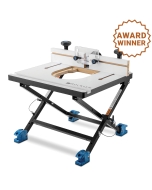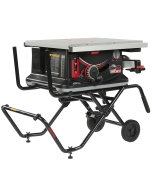Outfitting Your Small Shop
Setting up shop can be big fun. How do you do it and not spend big money at the same time? Benchtop tools may just be the answer.
The full complement of benchtop tools I'd recommend for building cabinets and furniture and for tackling home improvement wood projects includes a table saw, jointer, band saw, thickness planer, router table, drill press and combination belt/disc sander. I'd also include a power miter saw (it does overlap with the table saw just a bit, so consider it an optional tool if you wish). Let's look at each of these machines individually and examine what it can — and cannot — do, as well as explore a few suggestions for setting up benchtop tools in your shop.
Table Saw: Heart of the Shop
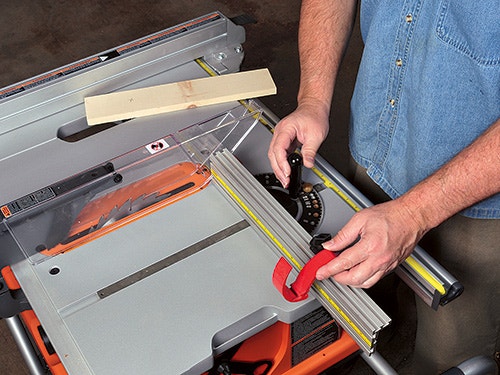
The centerpiece of woodworking shops both large and small, a good table saw lets you do a vast array of straight-edged cuts to tackle all manner of wood projects, from utility shelves to tables and chairs to kitchen cabinets. Although I usually recommend a 10" contractor's saw for its power and capacity, the majority of benchtop saws also sport 10" blades and are more portable and stowable, making them a great choice for shop-real estate-challenged woodworkers. Most benchtop models offer the same depth of cut as contractors' saws and a decent 24" rip capacity, although their universal motors (the kind found in portable power tools) are noisier and less torquey. To save your back from lifting and carrying drudgery, look for a benchtop saw that features an integrated folding stand. Folding stands make it easy to pivot the saw from a vertical storage position to a horizontal position, ready to go to work. Wheels on the stand let you roll the saw where you need it — to the site of the job or perhaps out onto the driveway, when it's a nice sunny day.
To get the most out of a benchtop saw, make sure it's fitted with a sharp, high quality, thin-kerf blade, which takes less power to run than a standard-kerf blade. If you often use the saw for crosscutting chores, consider buying an aftermarket miter gauge. Its long fence helps you cut longer stock more safely, and flip stops allow you to easily cut multiple parts to the same length.
Jointer for Straight Edges
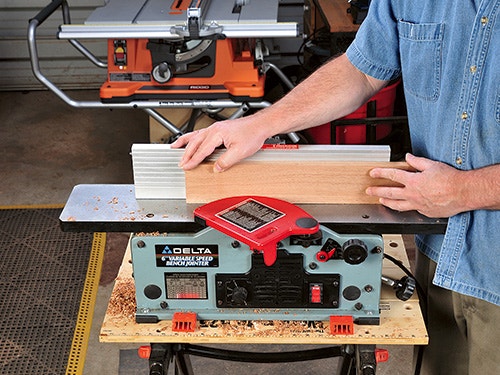
A serious cabinet and furniture maker might say that a table saw without a jointer is like an iPod without earphones — your lumber has to have a straight edge to go against the saw's rip fence or miter gauge for safe, accurate cuts. A sharp hand plane will do the job, if you have the skill and patience to use it, but a jointer makes quick work straightening edges, as well as flattening cupped boards in preparation for thickness planing. A stand-mounted cast-iron jointer with a 6" cutterhead and long tables is the standard for a small shop, but it takes up space. While a benchtop model doesn't have the power or table size to handle heavy, long stock, I've found it perfectly adequate for light edging or surfacing duties with shorter lumber commonly used for small projects. If you have heavier, longer boards to joint, you can switch to a router table.
Band Saw for Cutting Curves
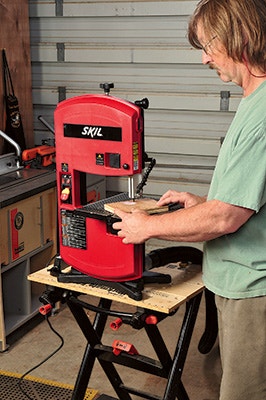
If curved woodwork is your thing, a band saw is an important purchase. For cutting out smallish-size curved parts, scrollwork and light resawing duties, benchtop band saws with 9"- to 10"-diameter wheels work well. Some models accept blades up to 3/8" wide and can cut wood up to 3-1⁄2" thick. Fitted with a narrower (1/8") blade, a small band saw can cut curves down to a 1/4" radius, so it can do many of the same cuts you'd do on a scrollsaw. If a compact band saw's throat depth isn't deep enough for cutting large panels or long/wide stock, you can always switch to a portable jigsaw. Just don't expect a small band saw to handle heavy cuts, such as sawing logs into turning blanks or resawing wide hardwood boards into veneers; step up to a 14" or 15" cast-iron band saw for these kinds of jobs.
Drill Press for Holes and More
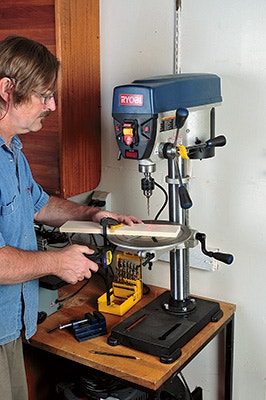
You can drill holes in wood with any portable drill, but when you need straight, true holes, it's hard to get along without a drill press. A benchtop drill press takes up very little space, yet it performs most of the hole-boring tasks that a larger, more expensive floor model does. Most 10" to 12" benchtop models sport 1/2"-capacity chucks, 5 amp (or larger) motors, and they offer three inches of quill travel, enough for all but the deepest holes. Simpler drill presses have stepped pulleys and belts that allow speed changes. More advanced models feature mechanical variable speed — handy for quickly matching motor rpm to the size of the bit and the application. For example, a quicker speed yields cleaner results when boring softer materials with a small-diameter bit. Some benchtop drill presses accept mortising chisel attachments, allowing you to "drill" square holes for joinery or decoration.
Router, in a Table or Handheld
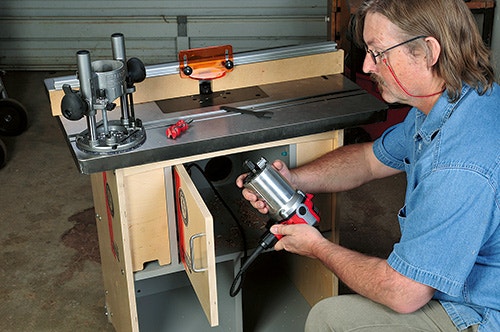
Few woodworking power tools are as useful as a router. But you'll get even more out of this versatile machine if you mount it in a router table. A good table's large surface, sturdy fence and slot-guided accessories (miter gauge, coping sled, etc.) allow a router to perform as a mini shaper or, fitted with a straight bit and offset fence faces, even as a jointer for straight-edging long boards. As a bonus, you can always remove a router from its table to use it freehand.(Hint: buy a router kit with two bases and leave one mounted in the table). A benchtop router table is light and easy to store, making it great for a cramped workspace. But if you have the room, buy a larger router table and stand or base cabinet.

A big router table not only offers better support when routing large panels and heavy boards, but it also can serve as an ample outfeed table for a table saw or other benchtop tool. A router table's cabinet base also offers useful storage for bits, tools and accessories.
Planer for Thicknessing

At some point in your woodworking, you'll no longer settle for building with pre-surfaced lumber that comes in standard thicknesses (3/4", 8/4, etc.). A portable thickness planer quickly turns rough planks into smooth boards that are just the right thickness for your project. Among the many planers to choose from, my favorite portables offer 13" width capacity that can handle wide stock and glued-up panels. I prefer planer models that feature reversible blades that are easy to change when dull and threeknife cutterheads, which yield more cuts per inch (for a smoother overall cut).
I like the two-speed versions which reduce tearout when planing woods with figured or problem grain (knots, interlocked grain, etc.). To ready it for use, I like to mount a planer on a low utility table, as shown in the photo below, rather than setting it on the floor (too low) or on a benchtop (too high).
Cleats added to the top and front edges of the template ensure alignment. I marked and rough-cut all six parts on the band saw, then flush-trimmed them to match the template.
Power Miter Saws, for Crosscuts

A table saw and miter gauge can handle many wood crosscutting chores. But if your projects often call for long stock or trim that's cut to precise length, consider adding a dedicated crosscut saw to your shop. Compound miter saws and sliding compound miter saws cut with the workpiece stationary (as opposed to the table saw), allowing safe, accurate cuts on even the heaviest and longest parts. Either type of saw makes short work of not only square cuts, but also miters, bevels and compound angle cuts, all set with minimal effort. The majority of powered miter saws sport either a 10"- or 12"-diameter blade. Sliding saws offer the greatest crosscutting capacity — up to 12" for 90° cuts. If you rarely cut stock that wide, consider a pint-sized compound miter saw. This affordable saw uses economical 7-1/4" blades, yet it can crosscut construction 2x4s and tackle compound cuts in frame members, trim and moldings up to 3-1/2" wide and 1-1/2" thick.
Combination Belt & Disc Sanders

A great complement to portable power sanders — belt sanders, random-orbit sanders, finish sanders, etc. — a benchtop combination (combo) sander doesn't take up much room, but it handles lots of different wood sanding chores. A combo model features a 4"-wide, 36"-long belt and a 6" disc. The horizontally running belt is great for flattening the bottom of a bowl or box, or for shaping small parts freehand. The belt's roller end is very handy for smoothing concave, curved surfaces. The disc sander's adjustable table and miter gauge allow you to accurately smooth part ends and edges, and the table tilts for sanding beveled parts. Just make sure to hook up your combo sander to a shop vacuum before putting wood to abrasive, lest you end up with a snoot full of fine dust.
Shop Vacuum — for More Than Just Cleanup
In a small shop filled with benchtop tools, a shop vacuum is an absolute necessity. Yes, of course, you can use it to clean up floors and benchtops, but more importantly, having a vac connected keeps chips and fine dust liberally churned out by benchtop machines at bay. Collection of sawdust not only saves your lungs, but it also actually reduces the dulling of blades, bits and abrasives.
When choosing a shop vacuum, buy the one with the largest capacity drum you can live with, especially if you'll use it with a thickness planer. Large chips quickly fill up a vacuum's drum, and the bigger the drum, the less often you'll need to empty it. Models with 2"-diameter flexible hoses are least likely to clog and are the easiest to connect to the majority of benchtop tools. Use an adapter fitting to mate hoses to ports of a different size.
Setting up Benchtop Tools

One thing that makes benchtop tools a great choice for small shop woodworkers is how compact, light and portable they are. You can use them when you need them, then store them out of the way when you're done. Smaller benchtops fit on a shelf, under a bench or in a cabinet when not in use, then clamp atop a workbench, tool stand or utility table for operation. If you have the space to mount several machines on a single worktable, make sure they won't interfere with each other during use. To make heavy tool bases or large stationary machines easier to move, fit them with locking casters or mount them on mobile bases.
Keep the inspiration coming!
Subscribe to our newsletter for more woodworking tips and tricks


